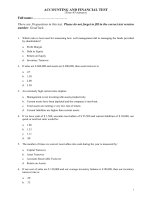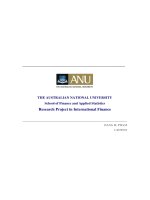VOWELS and CONSONANTS
Bạn đang xem bản rút gọn của tài liệu. Xem và tải ngay bản đầy đủ của tài liệu tại đây (1.53 MB, 14 trang )
Phonology deals with the following
questions:
1. Of all the sounds in a language, which
are predictable?
2. What is the phonetic context that
allows us to predict the occurrence of
these sounds?
3. Which sounds affect the meaning of
words?
PHONOLOGY
What is a phoneme?
A class of speech sounds that are
identified by a native speaker as the same
sound is called a phoneme.
The different phonetic realizations of a
phoneme are called allophones.
PHONEMES
CONSONANTS
When describing a consonant, use the
following parameters:
VOICE: do your vocal cords vibrate?
PLACE: Which cavity is involved? Which
articulators are used?
MANNER: how is the sound produced?
Phonemes of English
Try putting a hand lightly on your throat and then
say the following words, drawing out the initial
sounds.
If you feel vibration, this means that your vocal
cords are open and the sound in question is a
voiceless sound. If, on the other hand, you feel
some vibration or a buzzing feeling, this is due to
the vibration of your vocal cords which are closed
together. This means that the sound you are
making is a voiced sound.
Voicing
How is the air stream modified by the
vocal tract to produce the sound?
Stops : Sounds that are stopped
completely in the oral cavity for a brief
period of time.
Fricatives: If the air stream is not
completely stopped because of a narrow
passage in the oral cavity that causes
friction and turbulance.
Manner of Articulation
Affricates: a stop closure + slow release
(fricative)
Liquids: some obstruction formed by the
articulators, but not narrow enough to
cause any real constriction.
Glides: slight closure of the articulators,
they are almost like vowels. Therefore,
they are often called semi-vowels.
Consonants are produced with some closure
or restriction in the vocal tract as the air
stream is pushed through the glottis out of
the mouth.
When vowels are produced, there is nothing
in the vocal tract that narrows the passage
such that it would obstruct the free flow of
the air stream. That is, vowels are produced
without any articulators touching or even
coming close together.
CONSONANTS VS: VOWELS
Vowels are the most audible, SONORANT
(or intense) sounds in speech.
Vocal fold vibration is the sound source for
vowels. Therefore, all vowels are, almost
always, VOICED.
Unlike consonants, there is neither place
of constriction or closure (place of
articulation), nor a specific manner of
articulation.
The shape of the vocal tract determines
the quality of the vowel. There are several
ways in which we can change the shape of
the vocal tract:
1. raising or lowering the body of the
tongue
2. pushing the tongue forward or pulling it
back
3. rounding the lips
1. How high is the tongue?
HIGH , MID , LOW
2. Is the tongue advanced or retracted?
FRONT , CENTRAL , BACK
3. Are the lips rounded?
ROUNDED , UNROUNDED
4. Is the tongue tense?
TENSE, LAX
VOWEL CLASSIFICATION
Compare the vowels in ‘beat’ and ‘bit’, or
‘bait’ and ‘bet’.
TENSE vowels ([i],[u],[e],[o]) are
produced with greater tension of the
tongue muscles than their LAX
counterparts (all others)
TENSE vowels are phonetically longer
than LAX vowels.
EXAMPLE
If two sounds are separate phonemes,
then they are contrastive (in terms of
meaning).
If the two phones are allophones of the
same phoneme, then they are noncontrastive.
To determine whether a given pair of
sounds is contrastive, linguists look for
minimal pairs.
Aspiration: The period between the
release of the closure of a consonant and
the start of the vocal cord activity for the
vowel that comes after it. This period is
usually felt as a puff of air.
Aspiration occurs on all voiceless stops
occurring
as the first sound in a stressed syllable.
For English, aspiration is not employed to
create a meaning difference.
ASPIRATION
A minimal pair is a pair of words with
different meanings with exactly the same
pronunciation except for one sound that
differs.
Examples:
[tek] vs. [tep] "take" vs "tape"
[tim] vs [dim] "team" vs "deam"
Minimal Pairs









